Writing
-
Holy Saturday
We find ourselves with Mary, the mother of Jesus and the others who loved him, in a place of many overwhelmings this day.
The death of love, the brokenness of life, fear of the unknown, the fading of beauty, paradise lost, the going down into hell.
So many words to describe that word, hell. Underworld, Sheol, Hades, Gehenna, Abraham’s bosom. A place where we come face to face with our deepest dark, our fragility, our captivity to diminishment. A place of abandonment, no fragment of light.
Was Jesus’ death a dread defeat, a victory for demonic forces, a chilling vindication of those who destroy Christ, then or now? Not delivering on his promise to provide a new ordering of life, restoration, forgiveness?
On this day between crucifixion and resurrection, Jesus harrowed out of hell all the dead held captive there since the creation of the world. He took them by the hand and led them to Life.
‘When the gatekeepers of hell saw him, they fled; the bronze gates were broken open, and the iron chains were undone.’[i]
On this Holy Saturday, may we remember the ones
…who know their need, for theirs is the grace of heaven.
…who weep, for their tears will be wiped away.
…who are humble, for they are close to the sacred earth.
…who hunger for earth’s oneness, for they will be satisfied.
…who are forgiving, for they are free.
…who are clear in heart, for they see the Living Presence.
…who are the peacemakers, for they are born of God.[ii]And so we wait for the Third Day
in stillness
with a fragment of light
trusting and hoping…©Hilary Oxford Smith
Image Candle Light, Hans Vivek, Unsplash.com -
A Shadowed Path
Dawn on the Otago Peninsula. We awoke to the clarion call of a cockerel, heralding the blessing of a golden Autumn day. Jonathan Livingston Seagull shared wisdom in the sky. White feathered kotuku-ngutupapa or Royal Spoonbills, swept the low tide line of the harbour for breakfast. In the court of heaven on earth, four Royal Albatross or toroa, glided through the air, with what Herman Melville in Moby Dick, described as vast archangel wings.
William Wales, a tutor to the English poet, Samuel Taylor Coleridge and the astronomer on HMS Resolution, voyaged with Captain James Cook to the land of ice, the southernmost continent we now call, Antarctica. Inspired by hearing stories of the sea and a fabled land, Coleridge wrote The Rime of the Ancient Mariner, an epic tale about an albatross and the sailor who kills it with a crossbow.
The poem is replete with imagery, allegory, superstition, and allusion. The punishment for what the sailor has done is to wear the dead bird around his neck and the rest of his life becomes one of penance as he wanders the earth, telling his salutary tale. He learns wisdom along the way, that God's creation is a beautiful gift, to be cherished.
On Palm Sunday, we attended Choral Eucharist in St. Paul's Cathedral, Dunedin and sang, Ride on! Ride on in majesty! Sacrificial theology excepting, one line stood out for me,
Ride on! Ride on in majesty!
The wingèd squadrons of the sky look down with sad and wondering eyes to see the approaching sacrifice.I imagined that an albatross with vast archangel wings might be amongst the sorrowing company of heaven.
In the mystery of this week we call Holy, with its darkening shadows of pain and fear, abandonment, uncertainty, betrayal, and death, might we somehow contemplate in the stories, something of the novelist, Jeanette Winterson's words, the nearness of the wound to the gift?[i]
- Mary gently caressing the feet of Jesus with her long hair and extravagantly scented perfume, preparing him for what lies ahead.
- Jesus, with intimacy, humility, and oneness, washing the dust from the feet of his disciples.
- The mystery of the memory and substance of Jesus’ presence, as he and his friends share food and wine.
- John, the disciple, whom Jesus especially loved, placing his head on Jesus’ breast in closeness, affection and love, hearing the heartbeat of God.
- Veronica, tenderly wiping the blood and sweat from Jesus' face with her veil, his likeness forever imprinted on her heart.
- Simon of Cyrene, forced to carry the cross through the narrow streets of Jerusalem when Jesus could no longer bear the weight of it. His life changed forever.
- Jesus' mother Mary, the other faithful women, and John, accompanying Jesus every step of the way, hearing his loving words of familial care and loyalty.
- In his dying moments, self-giving love and grace shared with a thief, crucified beside him.Then the night of deepest loneliness. A total absence of his spirit and his life.
At dawn, wounds become places where the light enters us. Grace takes us to the cherishing of life and the nurturing of love. The images and the echo of words we thought we had lost or left behind create a sanctuary of memory in our hearts.
His eyes sparkle again. He tells stories by the sea. He blesses us with Love.
©Hilary Oxford Smith
Image Around the Shag Rocks, Light-mantled Sooty Albatrosses, Keith Shackleton, 1979. Nature in Art, Gloucester, UK.[i] Why Be Happy When You Could Be Normal?, Jeannette Winterson, 230pp, Grove Press.
-
Two Halves of the Moon
Like a Slope Point tree in Southland, a tree, windblown on the Arctic side, tinged with sea-salty rust, retreats ever inwards in the wild and briary glebe of the clergy house. It is the calm before another winter storm on this side of the world. Little penguin-like auks have been blown off course by the tempest of last week and are now regaining their energy in Noah’s Ark – the local animal rehoming centre. Rivers burst their banks, the turbulent waters ravaged homes, leaving silt and rainbow trout in their wake.
An Epiphany sun shone for an hour or so today. And my eye was drawn to wandering dolphins and orcas in the Firth and a weather-beaten fisherman hauling lobster creels onto his rusty fishing boat. There aren’t many lobsters about at the moment. The gourmands, dining in London restaurants, will have to do with monkfish.
Meanwhile, the people of the besieged Syrian town of Madaya, weep, as food finally reaches them. Starvation is used as a weapon of war in a conflict that grows more desperate with every moment. Prayers beam eastwards.
After Christmas, clergy need to drift away from the collage of parish life. I washed up on the Ardnamurchan Peninsula, a remote and wild place in the Western Highlands of Scotland. The landscape tells a harsh, sometimes violent, often sad story…of volcano fires, blood-soaked battles, the religious fervour of Irish monks, rampaging Viking invaders and Highland Clearances.
Like Alice Through the Looking Glass, it was as if I had entered a wormhole, travelling through a mirrored world of scarred mountain rifts, moine rocks, fossils and rainfall, to the vanished world of Central Otago.
Tramping in the Sunart rainforest, green with lichens, mosses and liverworts growing from bark and branch, I came across a clearing and a timber house, called Kaikoura - MÄori for ‘meal of crayfish’.
At land’s end, the most westerly point on the peninsula, stood the only Egyptian-style lighthouse in the world, with figurines of pharaohs, gods and sphinxes decorating the lamp base. In the fading light of a winter’s day, the Atlantic Ocean hurled itself at the beacon, biting pieces off the rocks.
I watched an unfolding ferocity that only the gods could have summoned. It was a night when the light would be needed most and I imagined that it beamed across the waters to Dusky Sound.
Back home in the village, the people celebrated the beginning of a three hundred year anniversary. In a New Year and in a bare hall, sheltered from the January cold, we looked back and, as I prayed for God’s blessing, we looked forward, to the unknown.
The schoolchildren sang songs about silver darlings, the Scottish name for herrings. If Alice had been there, she would have danced a lobster quadrille with seals, turtles and salmon.
Meanwhile, the air is sweet in a nativity summer. Kayakers paddle down the Clutha River and barbecues smoke on the beach. Yachts anchor in Half Moon bay as night falls, while children watch their shadows and play in the light of Curious Cove.
Two halves of the moon.
©Hilary Oxford Smith
Image Two halves make one moon? Flickr., Creative Commons 2.0 -
To be, or not to be...
The sun is setting on Assynt, in the North West corner of Scotland. Orange light warms a cold April. The mountains, Suilven and Ben More are iced with peaks of snow. Feathered friends make a snuggery, while a glistening otter gallops up the slipway with a wriggling trout in its mouth, its rainbow fate sealed. The white-tailed eagle has hovered over the loch for a day, searching for a salmon that escaped from the farm. Just when she smelt freedom, this god of the air snatched her away. So many worlds spin in pain.
At Cape Wrath, angry in the quietest weather, the Ministry of Defence carry out military exercises and propagate the news that they are also preserving the wildlife, flora and fauna of this special place. Meanwhile submarines creep into sea lochs doing what they do. Is there any place on earth not compromised by humanity?
I walk beside the stone remains of townships long since abandoned, kinship fragmented because of greed. Roofless churches in these parts tell the story of an ecclesiology and its earnest guardians who preached a misplaced morality and threatened doctrinal punishment and excommunication. The clergy banished the original spiritual beliefs of the people and yet somehow, the early Celtic Christian movement which managed to weave holy place names and traditions into the fabric of indigenous belief, survived. Over the centuries, many have heard an ancient song and harmony.
‘April is the cruellest month’, writes the poet, T. S. Eliot. Especially so, as we hallow the memory of New Zealanders and Australians killed in war. Such remembering is gathered to our hearts, not to glory the indescribable carnage of war nor gloss over the brutalising and crushing of the human spirit. We do not gather the dead and dying, the grief and sadness, the memories, stories, tragedies, the comradeship in life and death, to dis-member them. Rather we re-member them. This is restorative, moving us, not only to give thanks for the gifts of life and freedom which we take for granted, but to bring to birth, in our own hearts and lives, a harvest of goodness, justice and peace.
Every Sunday morning before going to Church, I listen to Sunday Worship on the radio while eating a breakfast of poached eggs on toast. Today the service was broadcast from Holy Trinity Church, Stratford-upon-Avon, the town where William Shakespeare was born and lived and the church in which he was buried.
He died 400 years ago on the 23rd April 1616 and throughout the world, words, music, art and place honour the legacy of probably one of the greatest writers that ever was. William had a lot to say about war: its legal, ethical and religious justifications, the ties between church and state in promoting and waging war, the costs to humanity, and the political strategies used to downplay internal problems and unite a nation around a leader whose legitimacy is in question…’ to busy giddy minds/With foreign quarrels’[i]
He also knew the devastation of grief. His only son, Hanmet died at the age of 11. We know little about his faith yet he writes in The Winter’s Tale, ‘then shall be brought to pass the saying that is written, Death is swallowed up in victory’. He also knows the inner voice of doubt, ‘Ay, but to die, and to go we know not where’.[ii] Resurrection, the deepest hope for our common humanity, was often in his mind. Lives could also be changed because of love, loyalty and miracles. [iii]
I made a visit with my late father to Stratford-upon-Avon in my salad days.[iv] Days when I thought that the ancient houses were higgledy-piggledy and the very fat swans on the river were hungry. I fed them and they obligingly ate what they were given. Dad took me to the Royal Shakespeare Theatre and we drank hot chocolate with lots of cream on top.
I cherish a tiny leather book of quotations from Shakespeare’s plays which he gifted to me on that day. I did not understand the words then. Now I realise that the Bard’s words are embedded in our language…
The course of true love never did run smooth[v]; For goodness sake[vi]; Neither here nor there[vii]; Eaten out of house and home[viii]; A wild goose chase[ix]; Too much of a good thing[x]; The world’s mine oyster[xi]; Not slept one wink[xii]; Send him packing[xiii]; Own flesh and blood[xiv] ...and so many more.
On this Sunday evening, snow is lightly falling as I look out of the window of the Clergy House. Jonathan Livingston Seagull and his partner roost on our roof after spending the day making a home for their young. They are our guests every year and we welcome their wisdom:
Don’t believe what your eyes are telling you. You have to practice and see the real gull, the good in every one of them, and help them to see it in themselves. That way you’ll see the way to fly and that’s what I mean by love.[xv]
©Hilary Oxford Smith
April 2016[i] Henry IV
[ii] Measure for Measure
[iii] Sunday Worship BBC Radio 4, Sermon by the Rev. Dr. Paul Edmondson, Shakespeare Birthplace Trust
[iv] Anthony and Cleopatra
[v] A Midsummer Night’s Dream
[vi] Henry VIII
[vii] Othello
[viii] Henry IV
[ix] Romeo and Juliet
[x] As You Like It
[xi] The Merry Wives of Windsor
[xii] Cymbeline
[xiii] Henry IV
[xiv] Hamlet
[xv] Jonathan Livingston Seagull, Richard Bach -
From Glastonbury to Iona
Holidays often begin in weariness. Everyday mundanities soon give way to tantalising glimpses of a different life.
The ferry left a misty Oban and arrived at the jetty on Iona where the weather turned bright. Wild and remote, the villagers of this tiny island in the Atlantic Ocean know how to walk against the unbridled wind. Yet in what has been a curious summer of weather, the sun shone for longer than a day and my skin glowed. Freckles became uncountable.
I discovered coves and caves for the very first time, dreamt of ancient legends that spoke of truth and possibility, walked across fertile flowered machair and awoke at dawn to the rasping sound of grey and chestnut plumaged corncrakes, secretive visitors from Africa. They opened my eyes to the illusory rising of two suns.
The Bay at the Back of the Ocean, the Hill of the Angels, the Gully of Pat’s Cow, the Port of the Marten-Cat Cliff, the White Strand of the Monks and tide-dancing for tiny polished beads of serpentine at Columba’s Bay, beckoned. Ragged robin, St. John’s Wort, bog myrtle and orchids grew in a landscape of translucence and light.
I stayed at a small island hotel. The bread-maker rose early in the morning to prepare her gift and the smell of earth’s fragrance wafted through the house. Fresh organic bread, rich and moist, full of seeds and nuts, carrying the gentle life and death secrets of grain.
The Abbey remains the summer-hour destination for coach weary day-trippers and those escaping the noise and grime of city streets and isolated urban spaces. They come to a remote place and feel at home. At sundown, the island gives itself back to resident dwellers while kittiwakes and sea eagles, like sentinels, soar around this thin place.
When St. Columba made his bittersweet landing on Iona’s shore, the story goes that he chose it because he would not be able to see his beloved Ireland. Drawn to a world beyond his knowing, Columba’s home-sickness must have been like the ache of an uprooted plant with only courage and faith to hold it up. He became grounded in new soil.
And so on to the opalescent mist of Glastonbury, popularly known for its music festival of Vee Dub tents, welly boots, boho, wild flowers in the hair, mainlining acts and mud.
This is Camelot, the Isle of Avalon, a place of disappeared kingdoms, myth, intentional well-being, religious and New Age pilgrimage. Sitting amongst the ruins of Glastonbury Abbey, in the drizzle of a mild September day with the ‘once and future’ King Arthur and his wife, Guinevere, reputedly lying buried nearby and with centuries of fireside storytelling warming my imagination, I felt as though I was searching for the rainbow’s end.
Legend has it that Joseph of Arimathea, the great-uncle of Jesus, who placed his nephew’s body in the tomb after the Crucifixion, later made his way to Glastonbury with eleven companions, bringing with him the Holy Grail, the cup used at the Last Supper.
Glastonbury was once an island. It can be seen from a great distance because of the Tor, a hill of some 500 feet, crowned by the 14th century Chapel of St. Michael. Joseph is said to have buried the chalice near the Tor and to have founded the first Christian church in Europe at this Place of Dreams. Resting on Wearyall Hill, he stuck his staff into the ground where it miraculously took root. The Glastonbury Thorn blooms each Christmas.
Great saints over the centuries, Dunstan, Columba, David, Bridget, Patrick and others have journeyed to this sacred and mysterious place as have so many of us ordinary mortals before and since, because not only did Joseph of Arimathea walk there but also Jesus himself.
The mystic, artist and writer, William Blake toyed with that possibility when he penned in his poem, Milton, some verses which became known as the hymn Jerusalem,
And did those feet in ancient time
Walk upon England's mountains green?
And was the holy Lamb of God
On England's pleasant pastures seen?What happened in this place of unravelled threads?
Richard Bach, author of Jonathan Livingston Seagull wrote, ‘not being known doesn’t stop the truth from being true.’ A rainbow coloured the Avalon sky in the late afternoon. I knew that I might never find its beginning or its end. It matters not.
©Hilary Oxford Smith
Image The Tor, Glastonbury, Hilary Oxford Smith
-
Northern Lights in April
Travelling is in the DNA of most New Zealanders. Over a million of them live overseas and thousands holiday around the world each year. Families love nothing better than packing up the tent, caravan or camper van and hitting the road to enjoy some R and R. If you’ve got an iconic V Dub, all the better.
Clive and I are currently working in Scotland and have been missing the camping adventures that we enjoyed in New Zealand. A wee camper van has now been added to our life and after Easter, we set off on a tiki tour…
By the lakeside at Windermere on an April evening, the water mirrors the still sky. Trees are not yet in leaf. Buds await with quivering intensity. A few boats are about. The day has been one of hot sun and a cold wind. Late snow fell on Helvellyn in the early hours. The daffodils, so redolent of this rugged and wild landscape, are in their dying days.
Nesting for endless hours in the reedy bank is a cob Mute swan. His mate has been swanning around all day looking for food. Non-native Canada geese honk here and there. Conservationists say that they are compromising the habitat and need to be ‘managed’. Waterskiers on the lake fall into the same category.
William Wordsworth wandered here, lonely as a cloud o’er vales and hills. Daffodils inspired him to write some words which have earned themselves a place in popular poetic consciousness. He wrote better poetry though. Mystical, spiritual poetry, most of it, glimpsing divine unity in all living things.
When the rain teemed down and made the black slate houses blacker, the far distant mountains sang ‘the still sad music of humanity’ he wrote. When he felt the loss of that visionary light, his ‘Ode on Intimations of Immortality from Recollections of Early Childhood’, revealed that the memory of it never left him.
Samuel Taylor Coleridge, a friend of his wrote The Rime of the Ancient Mariner at the village of Grasmere, a place described by Wordsworth as ‘the fairest place on earth’. Like so many of his contemporaries, Coleridge was addicted to opium, commonly prescribed then for everything from a cough to vague aches and pains. He scribbled Kubla Khan after dreaming of the stately pleasure-domes of a Chinese emperor.
Another Lake poet, Thomas De Quincey wrote an autobiographical account of his addiction, Confessions of an English Opium Eater which became an overnight success. The opium dreams did not last for these poets of the Romantic School though. Such imaginings may have presented them with unique material for their poetry but it gradually took away from them the will and the power to make use of it.
There are two villages called Near and Far Sawrey. Between the far and the near, is Hill Top, a 17th century farmhouse that brought the kind of childlike imagining I had put away. Beatrix Potter, the writer and illustrator bought the property with the profits from selling her first book, The Tale of Peter Rabbit, written first as a picture and story letter to cheer up a five year old boy who was ill.
Most writers have to learn to deal with rejection at some time or another and she was no exception. After several snubs from publishers, she finally landed a publishing deal for the story of this rebellious rabbit.
Potter’s own remarkable tale was that of a young woman who finally freed herself from demanding and possessive parents and achieved independence and fulfilment by her own efforts. The farm became her sanctuary, a place where she could draw, paint and write about lovable and villainous anthropomorphic animals and the triumph of good. Her stories are not only for little children.
And then on to rural South West Scotland and the ordination of a good friend. Farms and houses are scattered far and wide in his new parish and I was reminded of the 18th century diaries of Norfolk clergyman, James Woodforde who led an uneventful and unambitious life except that for 45 years, he kept a diary chronicling the minutiae of life in the parish. His was an endearing pastoral ministry by all accounts, that went hand in hand with a liking for roast beef dinners washed down with copious amounts of claret and port and always shared with friends. His legacy is a jewel of a diary that illuminates the darkest of times.
Wordsworth worshipped at St. Oswald’s Anglican Church in Grasmere. He found it a comfortless place apparently. I can see him sitting on a hard bench, his feet on the earth floor which would have been covered with rushes, with the only heat coming from a tiny grate in the vestry, burning wood and charcoal. In his later years he warmed to the church when he wrote Ecclesiastical Sketches, a history and defence of the Anglican Church. He had grown to like its moderation and tolerance which he regarded as its strength, tempered through centuries of conflict and trial.
In the churchyard at St. Oswald’s, lie his remains and those of his wife Mary, sister Dorothy and his children, Dora, Thomas and Catharine. The poet Harley Coleridge, son of Samuel Taylor is also a neighbour. Alfred Lord Tennyson said that ‘next to Westminster Abbey, this to me is the most sacred spot in England.’ He may well be right.
©Hilary Oxford Smith
April 2015Image Northern Lights at Bow Fiddle Rock, Portknockie, Scotland. Alexander Dutoy
-
Northern Lights in June
A New Zealander arrived on our doorstep last week, cold and alone. The early British summer had finally got to him. The Manse, which is the Scots name for a clergy house, was marginally warmer than the temperature outside.
When we lived in New Zealand, my memories of childhood summers in Britain were building sandcastles on the beach, eating ice-cream with sprinkles, skipping through fields of daisies, being an imaginary fish in the sea. Now I remember what I had chosen to forget. That it all happened in the cool wind and rain with glimpses of sunshine.
Our Kiwi friend, who is discovering his family history, was en route to the Orkney Islands, that archipelago, far north. Weather forecast grim. The Orcadian Sabbath is a day of rest, he said. Nothing to do except go to church. Which he did, at St. Magnus Cathedral. Afterwards he read The Observer newspaper, from cover to cover in the relative warmth of a B and B in Kirkwall.
The Cathedral, one of the finest medieval churches in Europe, is known as ‘The Light of the North’, founded in 1137 by the Viking, Earl Rognvald in honour of his uncle, Magnus. Thereby hangs a saga of political intrigue and dirty deeds. Since those early days, the Roman Catholic, Norwegian, Scottish Episcopal and Presbyterian Churches have all claimed the building as their own. Yet the Cathedral has never been the property of any of them. It belongs to the people, assigned to them by King James III of Scotland in a charter of 1486.
Meanwhile, back at the ranch, there have been baptisms, confirmations, a wedding and funerals. We yearn for markers in the transitions of life. This is where the Church comes into her own, offering an embodied love through the rites of passage that give meaning to the passage of time and experience.
Another kind of embodied love is happening at the Findhorn Community which beckoned me earlier this week when the sun came out. In the swinging ‘60’s, Eileen and Peter Caddy and Dorothy Maclean found themselves without work.
With their children, they lived in a caravan on a wild and windswept shore. Feeding six people on unemployment benefit was almost impossible so they began to grow, from poor soil, amazing flowers, herbs, fruit and huge vegetables. Word spread, botanists and horticultural experts visited and the garden at Findhorn became famous.
The longing of these three friends was to 'bring heaven to earth'. Others joined them in that hope and now the Community commits itself to a sustainable, holistic way of life and a spacious spirituality. I whiled away some time in one of its smaller gardens. Bees were about, water tumbled over rounded stones, carrots and capsicums grew in the midst of late bluebells and old roses, lemon balm, sage and lavender. A lady wearing a floppy straw hat sat in a shady corner, back straight, eyes closed, calming her mind.
Two small and beautiful books of poems and prayers arrived in the post a few days ago. Written by friends in New Zealand, Where Gulls Hold Sway and Be Still were companions on that afternoon of perfect light. The touch of new paper, the smell of ink and glue, the physical turning of the page with thumb and finger, the reading of words that read me…what is this heaven?
Later this month, at Stonehenge, a mysterious formation of stones in perfect alignment with the solar events of the Summer and Winter Solstices, there will be many peoples, who will gather in a spirit of togetherness, to celebrate the Light on the longest day of the year.
In the Southern Hemisphere, on the same date, the Winter Solstice will gift quietude, firelight, restfulness, while seeds germinate in the cold earth. Our ancient ancestors knew the sacredness of such times.
Memory recalls a visit with Clive, to a recumbent stone circle in Scotland with the almost unpronounceable name of Easter Aquhorthies. It happened many moons ago, in the early hours of a Summer Solstice morning when we were first in love. We cooked eggs on a makeshift stove for breakfast and then watched the pink porphyry, red jasper and grey granite stones, placed there over 4,000 years ago, change colour in the enchanted light. It seemed as if the whole world was open before us.
The earth spins around, time passes in minutes and millennia. We come, we leave, we meet again. One story.
©Hilary Oxford Smith
Image Caithness Croft, Deborah Phillips -
Spero: I Hope
“It was now about the sixth hour, and darkness came over the whole land…for the sun stopped shining.”
The heavy cries of the swooping seagulls fell silent and a chill crept into the air as the Moon came between us and the Sun. The deep shadow, which formed first in the North Atlantic, swept up into the Arctic and at the North Pole became no more. As the recent solar eclipse reached totality and the irridescent crown of the corona surrounded the sun, words from Pádraig Ó Tuama’s poem, In-between the sun and moon came to mind:
“In-between the sun and moon,
I sit and watch
and make some room
for letting light and twilight mingle,
shaping hope…”[1]I first came across this Irish Bard when a writing scholar at Vaughan Park said to me, ‘oh, you must discover him’. So I did. Actively involved with the Ikon collective in Belfast, The Corrymeela Community and the Irish Peace Centres, Ó Tuama gives an earthly and transcendent voice to life, troubles and hope.
The lamps are going out over Syria, reports Gerald Butt, the Middle East correspondent of the Church Times. According to satellite imagery at night, the destruction of 83% of lights in the country has plunged most of this fertile crescent into darkness.
After four years, the war rages on and highly publicised extreme violence by cross-border terrorist groups and the myriad violations of international law and human rights committed on all sides has spread to other countries and engendered fear and atrocity across swathes of the world. Fighting men and praying men lie side by side…their harmony together is found in rounds of fire and occupation. For most of us, what is happening is a scenario too stark, too horrible, too brutal to fully contemplate over breakfast or at any other time.
There are those in the three Abrahamic faiths who preach from lofty heights where the air is cold, that what is happening in Syria is linked to Biblical and Islamic prophecy about the End Times. As they turn a well-thumbed page of The Revelation of St. John the Divine, they confidently propagate their thirst and hunger for Doomsday while ten million innocents have fled their homes, are without shelter, war-ravaged, hungry and thirsty. Many people are not even able to bury their dead.
To mark the fourth year anniversary of the war on 15th March, #With Syria, a campaigning coalition of more than 130 humanitarian and human rights organisations, including Amnesty International, Christian Aid, Oxfam and Save the Children launched a video, ‘Afraid of the dark’[2], calling on world governments to do more to end the suffering of the people.
Thanks be to the people who refuse to let hope die and live Christ’s gift of peace.
“Blessed are the peacemakers for they shall be called the children of God.”
The bones of a Plantagenet king, on the throne some 500 years ago, were unearthed by chance and, watched by thousands, were re-buried within the small and beautiful Leicester Cathedral a few days ago. Richard III died in battle at Bosworth Field in 1485 and his body was buried by Franciscan monks in a simple grave. Leicester City Council unknowingly covered his burial place with tarmac and made it into a car park. Cardinal Vincent Nichols, the Roman Catholic Archbishop of Westminster, acknowledged that Richard was not a man of peace. “The time into which he was born, and the role into which he was born, did not permit that. But now we pray for his eternal peace.” History is sometimes seen through a glass darkly. “What is truth?” asked Pilate. “
There are fragments of who and what we are in all the characters and events of Passiontide and Resurrection:
“ The soon –to-be Easter light…
highlighted the night between
our fallings and our flyings
on this Friday of our good sorrows,
or bad sorrowsour mad, and sad,
and
glad that there are gladder days beyond these days sorrow.We toast the night, o felix culpa,
and hide the light of lightsfor a while”[3].
In Scotland, where I am currently living and working, the dying days of winter are giving way to Spring. The heavy rains have almost gone, the flowers appear on the earth, the blackbird sings. Autumn in Aotearoa heralds a different season of colour, of ripening and fruitfulness, where new thresholds and possibilities beckon and emerge.
Wherever we live in the world, can we trust the Easter promise of these openings and unfurl ourselves into the grace of new beginnings?
Jasmine is the symbolic flower of Damascus. In April each year, there used to be a Jasmine festival held there. It still blooms amidst the rubble and fragrances the air.
©Hilary Oxford Smith
31 March 2015Image: www.yesicannes.com
[1] Ó Tuama, Pádraig, readings from the book of exile, Canterbury Press, Norwich, 2012, p. 12
[2] Afraid of the Dark, https://www.youtube.com/watch?feature=player_embedded&v=EWwLzEQazcc
[3] Ibid., Good Friday, p. 16
-
Northern Lights in May
A golden and warm sun rose early on the first day of summer, May Day. The distant hum of a lawnmower reminds me of how much the lawn is part of this country's identity. Think cricket and the sound of leather and cork on willow, cucumber sandwiches and Earl Grey, afternoon strolls around the park, strawberries and cream. Antidotes to unpredictable weather.
It is blowing a howling, living gale outside. Our two puppy dogs think that wolves are about. Ferries have given up sailing to the islands, trucks are travelling by the low road and white horses ride the waves. Rudyard Kipling evoked the destructive possibilities of the sea in his poem, White Horses. Migrants from Africa, escaping to Europe and fleeing from fear, poverty, dispossession, know about white horses only too well. And still they ride the waves every day…some never reach the shore.
‘Be tough on immigration’ say those who believe that a mixture of boat tow-backs and harsh detention centres on remote islands is the solution to stop people smugglers and prevent deaths at sea. The delusional seduction of ivory towers.
In 1915, Kipling’s son, John, serving with the Irish Guards, went missing in action at the Battle of Loos. Kipling later served on the Imperial War Graves Commission and chose some words from Ecclesiasticus, which have been inscribed on many war memorials since: 'Their Name Liveth For Evermore'.
The names of those who died because of the badly planned, ill-conceived and disastrous Gallipoli campaign were remembered here on April 25th as they were in the Southern Hemisphere and elsewhere. After nine months of bloody slaughter, Winston Churchill, the ambitious First Lord of the Admiralty resigned. He lived to fight another day of course, spurred on by keeping a whisky going throughout the day.
The 70th anniversary of VE Day was commemorated last week. A fleeting, heady celebration back then, masking the loss and regret, the dispossession and homelessness, the anger and frustration. Churchill and his Conservative Party were heavily defeated in the 1945 General Election. There is a time for everything and everyone.
Another Conservative Prime Minister, Margaret Thatcher, apparently read all 845 of Kipling’s poems on a short summer holiday in 1976. It must have been raining. The new Members of Parliament, recently elected in the General Election in the UK haven’t had time to read poetry. The posturing and bargaining has started, superseding news from the far South of John Key’s ongoing Ponytail-gate saga.
Prince Harry though has been basking in the limelight of an Aotearoan sun. With Uncle away, the new Royal baby brightened the nation’s mood here. Charlotte Elizabeth Diana weighed in at 8lbs 3oz. Her mother, Catherine emerged from hospital, a few hours after giving birth, looking beautifully blessed. Her father too. They are sheltering trees where their little daughter’s fledgling heart can rest.
On this Ascension Sunday, I have been asked to christen a baby girl called Emily who was born on the Feast of Stephen. She came into the world, like a Christmas rose, petals unfolding, gentle and fragrant. Her parents’ love and kindness has come into blossom.
If her destiny is sheltered, I pray that the grace of this privilege may reach and bless other children who will be born and raised in torn and forlorn places.
©Hilary Oxford Smith
May 2015Image: Findochty, Sally Gunn
-
The 13.30 from Inverness
There is something blissfully solitary about train journeys unless you feel minded to share stories with the traveller seated opposite who is, like you, bored with paperback melodramas, texting the world and fleeting fields.
I am not of that mind on the 13.30 from Inverness. The late afternoon landscape invites imaginings of toiling harvest workers gathering golden bales of hay, of ancient Celts standing in a stone circle as they watch the moon skim low over the hills like a great god visiting the earth, of King William the Lion’s army defending his Red Castle from Viking invaders. Brief encounters.
And then to Dundee, once described as the city of jam, jute and journalism and where the RRS Discovery, the Antarctic exploration vessel of Robert Falcon Scott and Ernest Shackleton was constructed in 1901. This magnificent ship is now anchored in a custom-made dock at Discovery Point on the Firth of Tay. She and her crew spent two years locked in sea ice in McMurdo Sound. Scott and Shackleton relocated the Southern Magnetic Pole and returned with the news that Antarctica was a continent.
Travelling by any method has its austere moments. It was the Italian poet, Cesar Pavese who mused, ‘…travelling is a brutality. It forces you to trust strangers and to lose sight of the familiar comfort of home and friends. You are constantly off balance. Nothing is yours except the essential things – air, sleep, dreams, the sea, the sky – all things tending towards the eternal or what we imagine of it.’
Luke was Paul’s travelling companion. Faith and patience must have been two of the many virtues this benign doctor and writer of stories was blessed with. Paul could be complex, volatile and difficult. On his mission he was tough and courageous and faced many challenges. Luke faced them too. As the old missionary neared the end of his life, with all his fellow travellers having deserted him or gone elsewhere, he poignantly wrote to Timothy, ‘only Luke is with me’.
Another teller of tales, Robert Louis Stevenson believed that ‘we are all travellers in the wilderness of this world, and the best we can find in our travels is an honest friend’. He finally ended his sunset days with Fanny, his wife and soul mate, on the South Sea island of Samoa enjoying wine which he said was like bottled poetry.
In the age of Ebola, there is a growing panic about leaving home shores for other shores. Even though medical staff and non-governmental humanitarian agencies have been working with the sick and the dying in West Africa for a long time, it has slowly dawned on the rest of the international community that this disease could be visited upon them. So now, politicians are on high alert, lining up to urge a greater response to this modern-day plague. The people are fearful and fear breeds fear.
American Dr. Kent Brantly contracted the Ebola virus while working in Liberia and survived to tell the tale. He will be returning to work there. ‘The Spirit that God has given us does not make us timid’ he said, quoting words from St. Paul. After all that he faced, it is remarkable that Paul was still able to write probably the most memorable description of love that exists.
Globe-trotting is in the DNA of most New Zealanders. Emigration is the story of this land. People have travelled across many oceans to settle here and never leave, some leave and some return. It was emigrants from all over the world who helped to build the country’s railways through hostile and mountainous terrain, deep ravines, criss-crossed streambeds. What a titanic achievement.
One of the most breathtakingly beautiful railway journeys in the world is the Coastal Pacific from Picton to Christchurch in the South Island. I think that the poet and railway romantic, John Betjeman would have loved it. He ‘…was not one who stood with duffel bag, Penguin biscuit and fish-paste sandwiches on murky days at the ends of platforms taking down the numbers of locomotives…’[i] Betjeman travelled by train for the journey, not to get somewhere. This leisurely meander through an enchanted land of long white clouds is probably just long enough to still the ticking of the clock and time-travel to an older world. Air, sleep, dreams, sea, sky – all things tending towards the eternal or what we imagine of it.
©Hilary Oxford Smith
October 2014
[i] Jonathan Glancey, John Betjeman, On Trains (York: Methuen, 2006) p. vii
Image: The Jacobite train wending its way to Mallaig on the West Highland Line www.scotlandrailways.com
-
To be silent is to be unfaithful
'Man is born free yet everywhere he is in chains. One man thinks himself the master of others, but remains more of a slave than they are.' [ii] So wrote the Enlightenment philosopher, Jean Jacques Rousseau in his book of 1762, The Social Contract.All of us have been and the generations to come, will be born into an inheritance of one kind of another. Part of that inheritance is that we are heirs of a world scarred by the internationalising and industrialising of the slave-owning and slave-trading nations of the past and that much historic prosperity has been built on this atrocity.Even if it is argued that we are not born free, are we not born for freedom and have to learn how to be free? Part of that process means facing up to the legacy we inherit without fear, excuse or falsity. It means thinking truthfully about where we have come from, how our cultures and habits were formed, how as people, communities and nations, we collectively got into situations that frustrated our best and good intentions.For centuries, if not millennia, slavery was taken for granted by many Christian and non-Christian people. The corporate sin of the Church was also complicit in and profited financially from it. Yet it was also a mass movement of Christians and other faith campaigners, slaves and free women and men, who woke up the conscience of an entire civilisation and brought about the abolition of the transatlantic slave trade over 200 years ago.World leaders and the media are speaking and writing much about 276 schoolgirls kidnapped over a month ago by Islamist militant group Boko Haram in Nigeria. Boko Haram roughly translated means 'Western education is sin.' Boko Haram's leader knows deep down that education has the potential to liberate the mind and heart and be an equalising force in society. For him and his followers, there can be none of that. He also announced in a video message last week that, 'there is a market for selling humans.' Fears are, that these young girls will be sold into domestic or sexual slavery. There is international outrage and a social media campaign, 'BringBackOurGirls', is gathering momentum.Deeply disturbing as this kidnapping is, the truth is that human trafficking - modern-day slavery: bonded labour, marriage/domestic/sexual slavery and slavery by debt or descent, still exists, yet it is not always worthy of the sustained, global attention we are currently witnessing.Advocacy groups such as Walk Free [iii] and The Global Slavery Index [iv] estimate that today, nearly 30 million children, women and men are sold as commodities, trafficked within their own countries and across international borders. Even though slavery is illegal in most countries of the world, it happens on every continent and especially in places where there are major hubs of demand.According to the United Nations [v] , it is women who are trafficked most. Many are kidnapped and sold into prostitution, sometimes by their own relatives. Criminal gangs bring them into countries illegally where they are made compliant by violence, intimidation, drugs and abused on an unthinkable magnitude. Children too are trafficked between countries, abused and exploited through bondage for labour, sex, warfare. Trafficking is a multi-billion dollar industry.Men are also trafficked across the world, usually forced to work in unjust and inhumane conditions. The Global Slavery Index reports that in New Zealand hundreds of men have been and are working in slavery-like conditions on foreign fishing vessels chartered to New Zealand companies, threatened, abused and forced to work 30 hour shifts with meagre pay, without breaks and adequate food. The Second Reading of the Fisheries (For Charter Vessels and other matters) Amendment Bill was heard in the New Zealand Parliament on 15th April 2014 [vi] . It is intended that the passing of the Bill will enshrine in law by 2016, our country's moral and ethical obligations to the safety and employment of those working at sea. With yet more talking to be done, the Maritime Union of New Zealand is concerned that the proposed Bill, which has been discussed and debated for over a year now, may not become law before the national election in September 2014.Human trafficking though is largely a hidden crime, with the faces and cries of those who are sold usually unseen and unheard. It flourishes in places where there is poverty, injustice, conflict, vulnerability, gender discrimination and exploitation by those who are more powerful. The degree of criminality involved means that one of the largest difficulties for public sector agencies is bringing traffickers to justice, as a prevention and deterrent. Even once rescued, individuals often want to avoid deportation, family shame, threats to themselves or their families, so they do not always feel able or free enough to tell their stories.Slavery is not too distant for it to matter to you and to me, yet we can feel powerless about what to do to bring about change. Social media, for all its problems and detractors, has given many people a voice. We are witnessing its power to mobilise a mass movement of protest against such atrocity. It is in the nature of fast-paced media and politics however, that if and when the girls in Nigeria are returned safely home and we hope that they soon will be, human trafficking and the enslavement of people will move down the list of newsworthy items. Social media posts will move on to another issue, another petition.Nevertheless, we can harness our own anger and sadness at what has happened and use that in a positive way that works towards eradicating poverty and the enslavement of human beings in the production of our food, clothes, the running of our homes, the care of our elderly and disabled and keeping our sex trade in business.We can be thankful that advocacy groups and other agencies continue to work hard to bring matters to the public eye and that some of our churches continue to find ways to work with such groups to keep the issue at the forefront of their social responsibility and pastoral care...by lobbying governments to sign up to globally binding agreements, monitoring the ways in which traffickers are pursued and prosecuted and victims are supported and regularly engaging with other faith groups and the media to raise awareness.On March 17th this year, the Global Freedom Network was launched to eradicate forced labour and sexual exploitation by 2020 after an historic agreement was signed at The Vatican. It was the outcome of a conference, which brought together Christian and Muslim people of faith and representatives of agencies working to end slavery. The signatories called for urgent action by all faith communities to 'set free the most oppressed of our brothers and sisters… Only by activating, all over the world, the ideals of faith and of shared human values can we marshal the spiritual power, the joint effort and the liberating vision to eradicate modern slavery and human trafficking from our world and for all time.' [vii]
In her book, Enslaved: The New British Slavery [viii] , Rahila Gupta writes, 'human progress must be measured by the extent to which we have ended slavery. We should be fighting for a future when the world truly belongs to all of us'.To be silent is to be unfaithful.©Hilary Oxford SmithMay 2014Image Nicola Green www.nicolagreen.com[i] I have borrowed this title from the title of a Church and Society Council Report to The General Assembly of The Church of Scotland, May 2007 www.churchofscotland.org.uk/speak-out/social-issues/human-trafficking[ii] Rousseau, Jean Jacques, The Social Contract, 1762, (Pacific Publishing Studio 2010) page 1[iii] www.walkfree.org[v] See www.unodc.org for more information[vi] See www.beehive.govt.nz, Second Reading, Fisheries (For Charter Vessels and Other Matters) Amendment Bill 2014, www.parliament.nz and www.slavefreeseas.org for more information[vii] www.cathnews.com[viii] Rahlia Gupta, Enslaved:The New British Slavery, (Granta 2008) page 302 -
On ANZAC Day
In 1941, when Japan entered the Second World War, the Marlborough Sounds, which makes up a fifth of New Zealand's coastline, was considered to be vulnerable to possible invasion. In the tiny, scattered settlements along the coast, a Home Guard, made up of women and men protected the sea and land as best they could.After the war, the Home Guard Games were held each year in the Western Sounds, so that those who had served in home defence and their families could meet, free from the threat of war. Now known as the Te Towaka Sports Day, local people still gather to enjoy time together.On Easter Monday, we enjoyed one of the most beautiful and awe-inspiring drives in the world to French Pass (Te Aumiti) in the Sounds. The road there, still largely unsealed and treacherous in places, was only completed in 1957. Between the headland of French Pass and D'Urville Island is a turbulent stretch of water. As the tide drops, a massive amount of water, banked up in Tasman Bay, gushes out to Cook Strait. When the tide rises, it rushes back in. With powerful currents, eddies and whirlpools, it is a passage feared and respected by mariners as well as being an area rich with the presence of dolphins, seals, orcas, seabirds and other marine life...a microcosm of the Creator's beauty and life.On the way to French Pass is the township of Havelock. When I was working as a journalist I came across a small boat moored in the harbour there, called Seagull. I subsequently wrote up her story for the newspaper. Now one hundred and nine years old, this trusty vessel went to Gallipoli on the hospital ship, SS Maheno. Anchored off the island of Lemnos, she operated as the ship's tender. With her brave and steadfast crew, she transported wounded and dying soldiers to the hospital ship. Her war service is recorded in the Royal New Zealand Naval museum. I have no doubt that the echoes of dismemberment, pain, suffering and deliverance still echo around her bulwarks. She has surely earned her quiet retirement.ANZAC Day on both sides of the ditch, seems to generate, somewhat ironically, the expression of conflicting viewpoints and ideas about what the day is really about. Isn't it though, a day to tread lightly, to be compassionate and to remember, with sorrowful love and gratitude, the ones who went to war in the paradoxical cause of peace, those who have lived and still live with loss, separation and lasting injury of body, mind and spirit since and all the countless others who have been and will be, on this very day, the civilian and military casualties of war?This year is the centenary of the beginning of the First World War. It was to be the war to end all wars. Yet in spite of the now widely acknowledged military blunders and the unimaginable loss of life, the history of the world tells us that there will always will be those, who with a deep paucity of spirit, want to dominate others and use whatever means at their disposal to fight for ultimate power and possession. Conversely, there have been and always will be the people who work tirelessly to resist such agendas, the ones who restore and reconcile and make peace.Amidst the discussions about the significance of ANZAC Day, which should be rightfully explored but not only in the few days in and around the 25th of April, the suffering and loss of so many can never be allowed to be buried in our memory or the national and world memory.It is decent and honourable to commit ourselves anew to creating a world in which all that is good and precious and shining will grow and flourish. What is ultimately remembered on ANZAC Day or on any Remembrance Day come to think of it, is, I want to suggest, not actually patriotism, jingoism, the glorification of war, the expression of nationalistic fervour. That is, arguably, a kind of easy reductionism. What is deeply remembered in the individual and national consciousness is the indiscriminate slaughter of humanity, the quiet dignity of the human spirit, the gold that is buried in the ground, the longing for peace, the sanctity of life, the indestructible power of love.Some of my family and friends served in the civilian and armed forces at home and overseas in two world wars and in other conflicts since. I have come to know as the years have gone by, that in spite of their own misgivings and apprehensions about the architects of war and the reasons for and consequences of war, they and others have much to teach us about courage in the face of fear and death, humility and strength, vulnerability and loyalty, endurance and suffering, peace and love.As we continue to reflect upon issues of nationhood and identity which appear to be intertwined with the commemoration of ANZAC Day, we might also reflect upon how we can become peacemakers in our own circles of life, for peace begins with you and me. The Church also has to be willing to prayerfully and demonstrably grow into a visible unity and be a sign of hope to our often divided world. It is easy to preach and pray about peace. The tough call is to make peace and live in peace with one another every day. That is altogether a much greater challenge.©Hilary Oxford Smith25 April 2014ImageCarillon, William Longstaff, National Collection of War Art, Archives New Zealand.During the course of the First World War, the New Zealand Expeditionary Force suffered 59,483 casualties of which 18,166 were fatal. Will Longstaff honoured the New Zealand fallen by painting a scene depicting the spiritual images of soldiers gathering on the beaches of Belgium and listening to the carillon bells in their home country. The painting is permanently housed at Archives New Zealand, Wellington, New Zealand. -
Passion
The spider webs glisten in the soft slanting light of a gilded Autumn in Aotearoa. The long white cloud has given way, for the moment, to golden luminosity. The intricate patterns and variations of the singing bellbird/korimako in the tree accompany my writing. In whatever way the song functions for this bird, unique to New Zealand, it is beautiful and compelling for me. I cannot imagine a world without birds. Such thoughts add poignancy to this season, soon to be farewelled. Storm clouds gather.It was Captain Cook who, in 1770, named the northernmost point of New Zealand's South Island, Cape Farewell, because it was the last land he sighted after leaving these shores for Australia at the end of his first voyage. The longest natural sandbar in the world, called Farewell Spit, is near the Cape. Whale strandings are common there. No-one really knows why. Volunteers from the aptly named Project Jonah know all about saying farewell.Jonah was regarded as a prophet in Islam, Judaism and Christianity. Inspired by his strange story of rescue and deliverance, those who work for Project Jonah care deeply about the welfare of whales and other sea mammals, their suffering and their needs. 'We believe that both animals and people matter,' they say. 'Whilst the animals are central to what we do, it's people that make our work possible'.In the Northern Hemisphere, there is another Cape Farewell, which juts out into the northern Atlantic Ocean at the southernmost tip of Greenland. It is the windiest region on Earth. Early Icelandic sagas describe the wild capricious winds at Cape Farewell blowing early Viking explorers from Iceland and Greenland off course to reach landfall in Canada and North America.Artist, David Buckland began The Cape Farewell project in 2001 as a cultural response to climate change. Moving beyond purely scientific debate to creative insight and vision, the project brings together artists, scientists, communicators from around the world...'The Arctic is an extraordinary place to visit...to be inspired...which urges us to face up to what it is we stand to lose', he says.The Paschal Mystery will soon occupy the thoughts of the Church and its people. Joyous song will give way to a walk with Jesus along the Via Dolorosa, the Way of the Cross, in Jerusalem. Over the centuries, millions of pilgrims have walked in His footsteps, beginning in the Muslim Quarter of that Abrahamic city along a winding path to the Church of the Holy Sepulcher in the Christian Quarter.We do not have to go to Jerusalem. People of faith, in the week we call Holy will, in their own places of devotion, accompany Jesus and meditate and pray about the events of His Passion and His dying on Good Friday.His disciples, family and friends faced the end of the incarnation, the end of Jesus' presence on earth. Yet His farewell words to them tell a different story - of love, comfort, change, hope. The poet-prophet from Nazareth encourages them, as he does us, to imagine the promise of the resurrection, of what is to come.Although our spiritual awareness may wax and wane, the love of the Divine gifts us all we need to fare well in the journey of life. It is a Love that inspires us to be appreciative and generate abundance, wholeness and the sustaining of life in all of creation.And the whales and the birds and the wind sing a holy song.©Hilary Oxford SmithApril 2014Notes and References:Korimako is the Maaori name for the BellbirdImage: Passion, www.lifedesignsbycathleen.com -
Solomon's Eden
Ever-growing concerns about the sexualisation of our young people are voiced in the home, the media, in public and policy reports as well as a plethora of popular books. Children, teenagers, adults are exposed on a daily basis, overtly and subliminally, to a diversity of sexual messages and behaviour on the internet, in printed media, film, television, in the lyrics and performance of popular music, in the fashion industry, in our exhibitionist celebrity culture.
Last week, new guidelines about the themes and tone of film and video came into force by the British Board of Film Classification. The findings of an extensive public consultation of over 10,000 people, including teenagers, underpinned the need for these guidelines. [i] A major concern expressed by respondents was the early sexualisation of young girls, the sexual and language content of music videos and the ease of accessibility by young people to online pornography. Risks to vulnerable adolescents of self-harm, drug misuse and premature access to sexual content in film were also considered to be a serious issue for a majority of respondents.
The world-wide web has brought about a radical change in the social and cultural environment for all of us and most especially for our children and young people. It can be, for them, a valuable learning, research, communication and fun tool to access and use through various technologies. Yet it is also the means by which they are vulnerable to the aggressive marketing of powerful companies who exploitatively promote and sell sex in different ways. Children and adolescents can fall prey to paedophiles and other criminals who use the internet to pursue their illegal and abusive behaviour.Research reveals that the average age of a child's first internet exposure to online adult pornography is 11 years old and that the largest consumers of it are 12-17 year old adolescents. Of that group, 27 per cent of boys are accessing it every week with five per cent viewing it every day. [ii] Sexualisation of young people is a complex topic because many of us perceive sexual connotations in different ways. Polarised opinions dominate the debate. There is, however, a broad consensus amongst practitioners, academics and others, that women are being portrayed more and more as embracing an ever ready sexual availability with sex separated from intimacy and love. Whereas research has indicated that young girls have the ability to criticise and deconstruct sexualised images, this also sits alongside very painful accounts of how bad such images can make them feel and the kinds of pressures they feel subject to. [iii]If young girls imitate examples of sexual expression from role models such as some minor celebrities, reality show contestants, young pop stars, porn stars and surgically enhanced women, most of whom are paid to increase sales and make money, depict instant pleasure, court controversy and shock, then the chances of girls finding true intimacy, connection, genuine love and passion could be diminished.Similarly, constructions of masculinity are often linked to sexual prowess and conquest. So-called 'Lads' Mags' boast covers with soft porn images of young women. The rough magic of being a bloke is promoted and free gifts of beer and condoms are offered to increase sales. Boys and young men are being sexualised in ways that could be regarded as neither healthy nor esteem building.Young people need to be encouraged and enabled to find a sense of personal integrity and a relationship with their bodies that is not based on sexualisation. Surely it is desirable for them to gain a knowledge of the wide range of other possibilities and potentials for living life to the full. Isn't this critical for their well-being and in their relationships with themselves and others? There is a deepening belief around that young people would benefit from becoming more media literate so that they are better equipped to critique sexualised and pornified popular culture. Such literacy would be linked to conversations about consent, coercion, violence and exploitation in sexual relationships. [iv]I have been reminded of a sermon I preached at St. Giles' Cathedral, Edinburgh, later published in Theology in Scotland. [v] One of the lectionary readings for the day was from The Song of Songs. Revisiting the text over the last few days, I think there are resonances for us in these present times.The only surviving example of ancient Hebrew love poetry, the Song of Songs is a tale of extraordinary eroticism, taking human sexuality seriously. Two young people express their love and desire for one another, unashamedly admiring each other's bodies and celebrating their love. It is the only book in the Bible whose principal speaker is an assertive, confident and happy woman in her own skin. She is strong, her partner is sensitive.Morals, marriage ethics, contractual obligations don't see the light of day. Neither is it an allegory even though there are those who interpret it as such. Over the centuries the Church taught that because of the Adam and Eve story, sex was sinful unless for procreation and women were the lure to that sin, their subjection, the consequence. [vi] The feminine voice was heard quietly, if at all. It is little wonder then that such sensual poetry was and still is, in some quarters, conveniently regarded in allegorical terms.The blush factor not spared, these young people capture the freshness of new, consensual love, enjoying a bond of mutual sharing and tenderness, expressing a sacred sexuality of joy, intimacy, reciprocal longing, mutual esteem and wholesomeness. Restraints and propriety are present and we are reminded that their sexual expression of love is neither trivial, cheap nor a commodity which can be bought and sold in the marketplace. Their loving grace and gracefulness, beauty and fragility refreshes our awareness.In all the diversity of our expressions of love and physical love, perhaps we need to be aware of what protects wholeness in our relationships. If this is forgotten all kinds of misuse and abuse can take place. Might we reflect that we may always be on holy ground and that this doesn't invite open license to do anything? Neither though, can such expression in the context of people's lives be confined within narrow prohibition.Rowan Williams, before he became Archbishop of Canterbury said in a speech about human sexuality,'…the moral question ought to be one of how much we want our sexual activity to communicate, how much we want it to display a breadth of human possibility and a sense of the body's capacity to heal and to enlarge the life of other people…' [vii]What God celebrates in all our expressions of love - physical, sexual, sensual, non-sexual is deep, selfless, uninhibited sharing – mind, body and spirit - in faithful, healthy and enduring relationships that reflect unconditional love and dependable fidelity.'…vital for human life…love alone can awaken what is divine within…a rhythm of grace and gracefulness…when love awakens in your life, it is like a rebirth, a new beginning.' [viii]©Hilary Oxford SmithMarch 2014[i] See www.bbfc.co.uk for details of the new guidelines and the results of the research[ii] Sex Education Survey, YouGov (2008); Livingstone, Beber et al (2005) Internet Literacy among children and young people, Go Online Project)[iii] Gill, Rosalind, Professor of Social and Culture Analysis, Kings College London, National Society for the Prevention of Cruelty to Children (NSPCC), Conference, Premature sexualisation: understanding the risks, 2011[iv] Coy, Maddy, Dr., Child and Woman Abuse Studies Unit, London Metropolitan University, NSPCC Conference 2011[v] Smith, Hilary, Revd. Dr., A Beautiful and Enriching Love, Theology in Scotland, 2008[vi] See Holloway, Richard, Godless Morality, (Canongate 1999) page 58[vii] Williams, Rowan, The Body's Grace, 10th Michael Harding Memorial Address to The Lesbian and Gay Christian Movement 1989, pages 4,5[viii] O'Donohue, John, Anam Cara, Spiritual Wisdom from the Celtic World, (Bantam 1999) page 26 -
A Salty Reverie
With elderly poise and grace, my four-legged friend slowly makes her way along the pathway to a favourite patch of grass. Minx and I have been together for fifteen years. So many adventures we have enjoyed. Days of climbing mountains, chasing rabbits and catching sticks now belong to her dreams.It is summertime as we sit at the water's edge. She loves the sights and sounds and smells of her world. Every now and then, we catch a glimpse of each other. Our time together so precious.It's a warm day. A day to do nothing except think or not think. Little boats with assorted generations of family on board, putt out of the harbour. Children in swimsuits play tag on the beach and tuck into fruit salad and jelly afterwards. Seagulls hover overhead, waiting for a piece of pineapple to come their way.Dreams and memories add to this salty reverie. I'm five years old again, on the beach at Blackpool in Lancashire, with my younger brother, Mark. We are wearing our new inflatable swim rings. Mark's ring has a horse's head, mine is a swan. The Irish Sea is always cold. Small guardians of the future do not worry about such things. Mum and Dad gently pull us into less shallow water, not letting go until, screeching with fearful delight, we insist on freedom. Afterwards, we head to the ice-cream parlour for banana splits all round. To children belongs the Kingdom of God.All this reminiscing comes to an end when two men in gumboots, argue furiously on the quayside over their catch of fish and I hear the gunshots of a pig hunter in the valley. Contemplative spirituality has to engage with the world.With her twilight perception, Minx has gifted me the wisdom that times of stillness and refreshment are vital to wholeness. Intense movement, busyness, work, justification of self, through the doing of deeds are endemic these days, not least in the Church. Many clergy, from Archbishops down, earnestly go about the business of religion attending endless meetings, compulsory personal development courses, supervision sessions, yearly reviews and formulating still more desperate strategies for mission. Yet what significant time is given to the heart of vocation - presence - sharing the sights and sounds and smells of other people's worlds and being refreshed in mind, body and spirit?The clergy of Jane Austen's time were not known to work onerously. As the daughter and sister of clergymen, Jane always included at least one vicar in her novels. Taking tea with parishioners was a most regular occurrence for them, as was reading in the study and if they were single, wooing a fair maiden. Henry Tilney in Northanger Abbey was noticeably absent from his parish for much of the year, retreating to the town of Bath. His lack of commitment would surely be questioned these days, yet he saw the world quite poetically and spiritually, '… I am pleased that you have learnt to love a hyacinth. The mere habit of learning to love is the thing.' For all his flaws, Henry Tilney took time to see the subtlest of things.Is it possible to find a still and quiet place in our hearts and lives?At the heart of Vaughan Park is the Ruatara Chapel. Three times a day, the community gathers there to mark the hours of the day, to pray for justice, peace and the integrity of creation and to value the ordinary as sacred. As most of us are rarely in a place where we stand and in the time that is now, this living of the canonical hours is a vital resource.The Book of Hours, popular in the medieval period, was originally written by monks who contemplated the nature of God in quietness, sometimes isolation. It contained prayers for specific hours of the day, days of the week, months and seasons, with illustrations to help the reader contemplate and meditate. It was read by all kinds of people from every strata of society, often carried in pocket or bag. The Liturgy of the Hours, The Daily Office, The Divine Services all originate from this early source of wisdom.Wisdom, I think, is a deeper way of knowing and living in rhythm with our souls, life and the Divine. It is about learning to balance the known with the unknown and linking the whole of life to a deeper Unity. Jesus withdrew to quiet places, in mind, body and spirit. He considered it wise.The Christian Church reminds us in early February of the story in St. Luke's gospel about the elderly priest and prophetess, Simeon and Anna. They waited many faithful years to bless the Christ Child and sensed the sacredness of the moment when he came before them. With the wisdom of age and the daily prayers of a lifetime, they saw God in Jesus and knew him to be the Light of the World.At Candlemas and at any other time, come to think of it, we light candles in response to Love, praying and believing that Light will shine where wars rage, hate burns, fresh water is but a dream, land is stolen and pillaged. We also pray that the Light will continue to shine in the lives of people who honour love, justice, truth, peace and hope. The Church, for all its flaws and in its goodness, still seeks the Light.Minx is resting at my feet as I write these words. Perhaps she is dreaming of a time when she swam in the river or when she licked away the tears from my face on the night Dad died. I gaze out at our garden. The boughs of the gnarled pear tree, planted some eighty years ago, are laden with fruit.©Hilary Oxford SmithImage Children sitting on wall at the seaside, by the artist, Marilyn Spence, www.marilynspence.co.uk

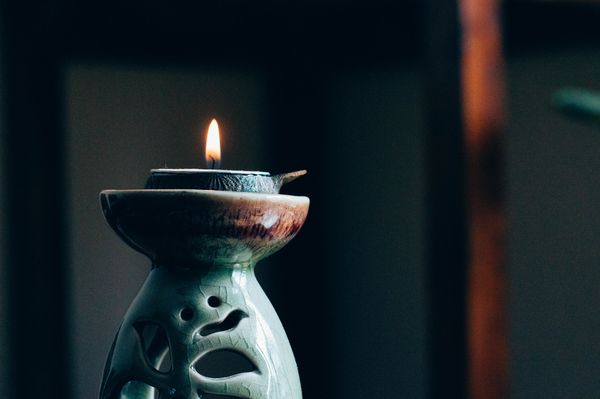
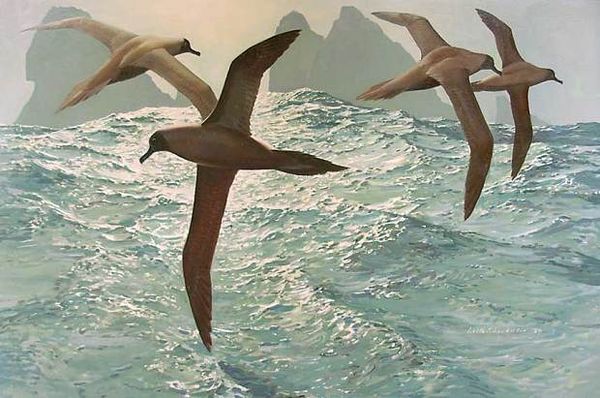
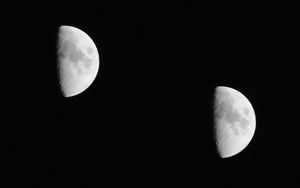
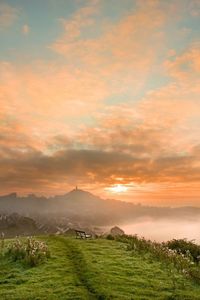
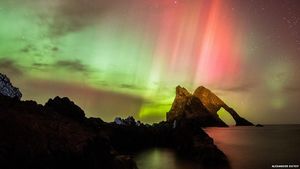
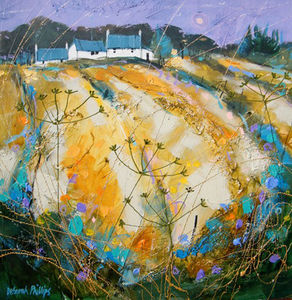
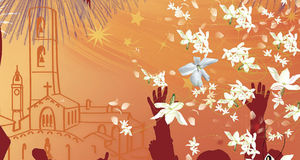
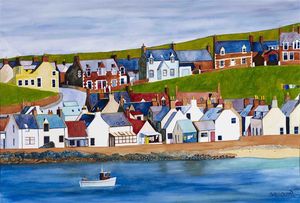
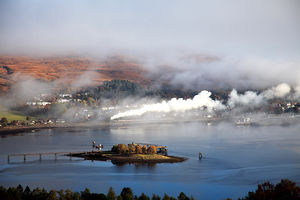
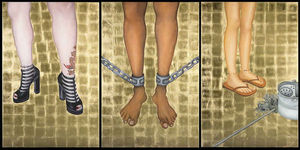
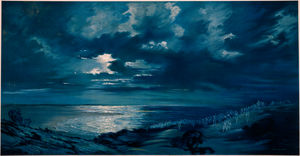
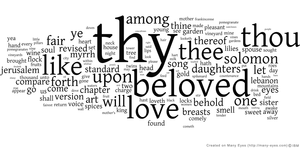
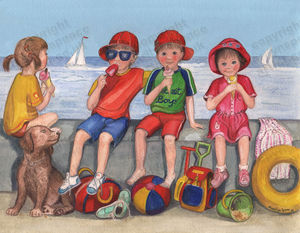


 Follow us:
Follow us: